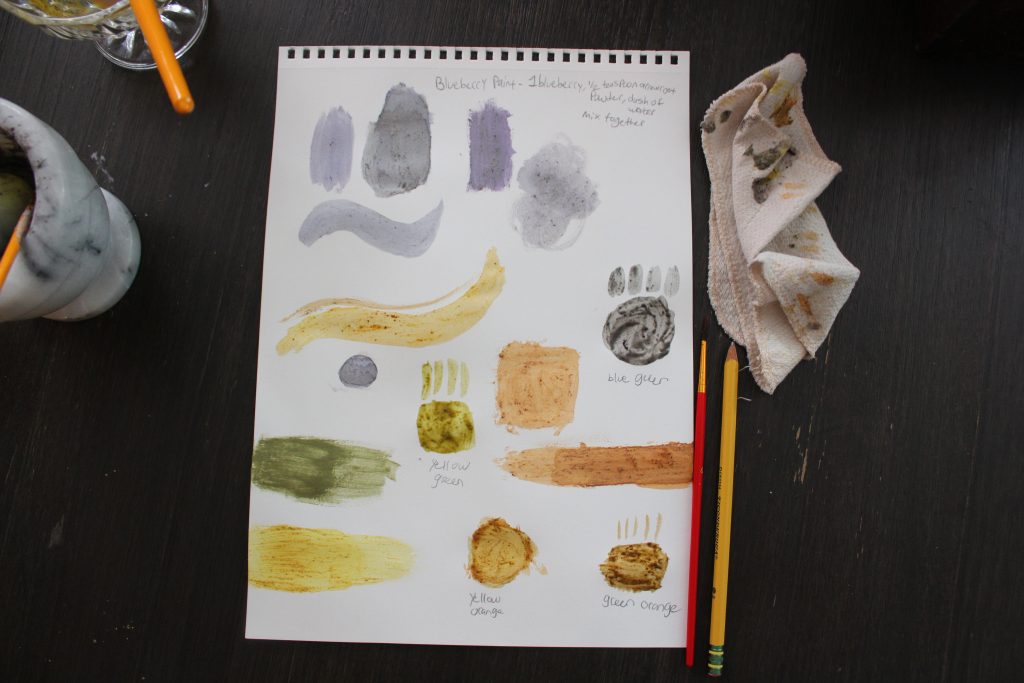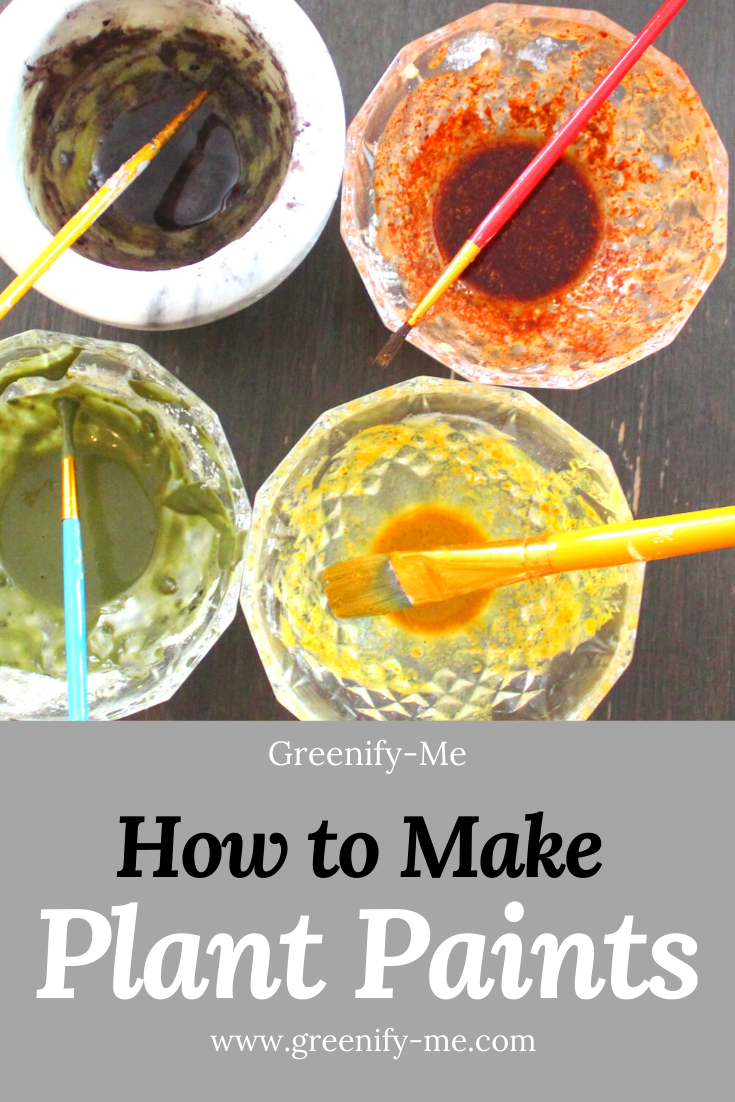Have you ever heard of plant paints? I love making them! This post was a long time coming but it stands to reason more of us should be using natural paints. Conventional paint sold in stores comes packaged in plastic bottles – and the ingredients are no better. Most paint used for crafts (and painting a house!) is actually a form of plastic, or another synthetic ingredient. It’s best to air on the safe side and choose plant paint for your crafting projects, especially when there are children involved. The fun doesn’t just lie in painting anymore – there’s also the act of making the paint that’s fun too!
I think painting with plants harkens back to our roots as human beings when things were simpler. It also forces us to get creative and think about colors and patterns. What do you get when you combine blue with green? How about yellow and green? What plant will make the one you need? Along with stimulating your senses, painting with plants opens up a world of appreciation for all nature gives us. And it’s refreshing to celebrate nature in a way that allows us to create so empathically.
As far as the zero waste aspect of it goes, plant paint is certainly a waste free alternative. You can get most of everything you need to make it with minimal waste. A bulk food store has all kinds of spices and herbs that would make great paint pigments. Also, farmers markets (especially in the summer) are great places to find berries you can use as paint! There are so many opportunities to create zero waste art, it’s uncanny. Even some plants growing in your backyard could be used as pigment – you just have to get creative.
Ready to pick up your paint brush and get to it? Here’s how to make plant paints and create some zero waste art!

What is plant paint?
Plant paints are essentially paints made out of plants! The pigments come from herbs, spices, flowers, fruits or leaves. So it’s exactly how it sounds. They’re all natural and non-toxic. If you paint using plant paints on paper or cardboard (which is your best bet), you can compost them without worry.
What are natural paints?
Natural paints are paints made from raw ingredients such as earth and mineral pigments. Plant paints falls into that category. Clays, chalk and marble can be used to make natural paints too.
The main requirement to be considered “natural paint” is for it to come from the earth, and break down over time. Now, this doesn’t mean your art should fall apart from using natural paints. This simply means if you were to compost it, it would be safe to do so.
Most paint sold on the market nowadays is derived from petrochemicals (aka oil-derived) or synthetic ingredients. Aka, you’re painting with plastic pretty much.
Because I like to paint on paper, which can be easily composted, I like the comfort of knowing my paint won’t prevent it from heading to the compost heap.
Craftamo also sells cruelty-free and eco-friendly art brushes worth checking out.

What about paint brushes?
I just use the same paintbrushes I’ve had on hand since I was a little girl. I always advise you use what you have, instead of buying new. This helps reduce the most waste!
If you don’t have any paint brushes, consider trying to thrift some, or using other means. I hear sponges can make for some really interesting textured effects.
You could also look into getting some natural paint brushes with wooden handles and non-synthetic bristles, as these can biodegrade.

How do you make plant paints?
To make the paints, I like to keep it very simple. I usually work with powders, as these are the easiest, but you can also use soft berries, petals and leaves and just grind them up in a mortar and pestle. I make these in small batches to be used right away, so that there’s less waste and no chance of spoilage.
- Berries or soft fruits: Use a mortar and pestle to mash the berry up. Depending on how much paint you’ll need for your project, you may need a lot of berries. Usually my projects are on the smaller scale so one or two berries proves to be enough. If it has a lot of seeds (like raspberries tend to), you may have to put it through a sieve.
- Petals or leaves: You’ll want to grind these up in a mortar and pestle. If they’re dry, you might want to blend them up in a blender or food processor to create a smoother powder with less tiny bits.
- Powders: These are the easiest to work with! You don’t have to do much of anything prior, it’s ready to use.
Here’s how I personally make plant paints.

Ingredients (for natural plant paints):
- Red/pink: 1/2 teaspoon of beet root powder or 1 to 2 raspberries, strawberries or cherries, or red rose powder, 1/2 teaspoon of arrowroot powder, 1/2 teaspoon of water
- Yellow: 1/2 teaspoon of turmeric powder, 1/2 teaspoon of arrowroot powder, 1/2 teaspoon of water
- Orange: 1/2 teaspoon paprika powder or chili powder, 1/2 teaspoon of arrowroot powder, 1/2 teaspoon of water
- Green: 1/2 teaspoon of matcha powder, 1/2 teaspoon of arrowroot powder, 1/2 teaspoon of water
- Blue/purple: 1 to 2 blueberries, 1/2 teaspoon of arrowroot powder, 1/2 teaspoon of water
- Brown: 1/2 teaspoon of cocoa powder, 1/2 teaspoon of arrowroot powder, 1/2 teaspoon of water
- White: 1/2 teaspoon of arrowroot powder, 1/2 teaspoon of water
- Black: 1/2 teapoon of charcoal powder, 1/2 teaspoon of arrowroot powder, 1/2 teaspoon of water
Extra colors:
- Yellow green – combine matcha + turmeric paint to make a spring bud kind of green.
- Green orange – combine matcha + chili paint to make a grungy, muddy kind of orange.
- Yellow orange – combine turmeric + chili paint to get a mustard kind of yellow.
- Blue green – combine blueberry + matcha paint to get grey.
To make these paints, just combine and mix them together in a little dish. You can add more water, pigment or arrowroot powder depending on how much you need, or how big your project.

Notes on plant paints:
The picture above showcases some of my swatches and experiments. These are the base paints I used to create things in this example – chili powder, matcha powder, blueberry and turmeric. It’s kind of amazing the amount of versatility you can get from just 4 colors.
I played around with so many things – creating ombres, layers, and combination colors. It was honestly a lot of fun!
It’s important to remember these colors will first appear a bit more vivid than when they dry. So be sure to experiment and have fun with it! Always do swatches first to see if it will achieve the desired effect.
Also, these paints will smell like what they’re made of, so if any of these scents bother you, try to avoid them.

In the spirit of fall, I also decided to paint a little pumpkin drawing I was working on (pictured above) using the chili powder, matcha and turmeric paint I made. It came out so cute!
It’s also important to note these paints have texture – as you might be able to tell from the pic above – they’re not just straight up smooth like acrylics. So please keep that in mind when working with them – you will get a fleck or two (or even 30!) of chili powder or blueberry skin in your art. But I think it adds so much character.
You’ll also want to be mindful of the fact these plant paints look different in the sunlight, opposed to low light. Certain colors can even change entirely after drying. I’ve found the chili paint takes on a more earthy orange brown hue after drying, for example.
Finally, it’s important to note you may not always have access to all the pigments on my list. Especially if you want to keep this as zero waste as possible. For example, blueberries aren’t in season after summer – unless you go to a grocery store and buy them in plastic, which kind of defeats the purpose.
I advise looking into different pigment options and getting creative whenever this problem pops up. You can freeze blueberries from the summer to have for your winter paint sessions, if you’d like. That’s one possible solution.

Would you give these plant paints a go? What are some of your favorite natural pigments to paint with? List them in the comments!
Did you know you can also make plant dyes too? Check out this blog post for the details: 15 Ways to Celebrate Earth Month From Home.
Enjoyed this post? Be sure to share it! If you like my content, sign up for my newsletter to get notified every time I write a new blog post. To support me even further, please consider buying me a cup of tea to help support my blog.

